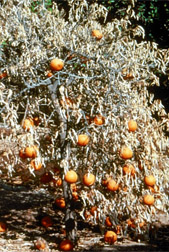This page has been archived and is being provided for reference purposes only. The page is no longer being updated, and therefore, links on the page may be invalid.
|
|
New Method Tests Severity of Key Citrus Virus
By Alfredo FloresDecember 24, 2009
A new rapid way to test severity of the devastating citrus tristeza virus (CTV) in citrus trees has been developed by Agricultural Research Service (ARS) scientists in Parlier, Calif. The results of this study were presented at the Second International Citrus Biotechnology Symposium in Catania, Italy, earlier this month.
CTV is the cause of the most economically damaging virus disease in citrus. CTV has led to the death of millions of citrus trees on sour orange rootstock worldwide, and virulent stem-pitting strains can drastically reduce fruit size, quality and production of millions of other citrus trees on tolerant or resistant rootstocks. Sour orange is generally considered the best overall rootstock (or tree stump) for citrus and is still widely used in Texas, Mexico, Central America, and Mediterranean countries.
In central California, typical CTV strains are mild, remaining symptomless on tolerant or resistant rootstock. This has led to the spread of symptomless CTV in recent years. Over time, if undetected, a virulent strain may be introduced or become predominant in mixed infections with mild strains. There are no high throughput diagnostic methods that distinguish between strains, which presents a real problem in detecting and eradicating the virulent infections.
At the ARS San Joaquin Valley Agricultural Sciences Center in Parlier, plant pathologist Ray Yokomi has developed a system to screen local CTV isolates for severity, using a technique called real-time polymerase chain reaction (PCR). Tree samples were tested in Parlier for CTV infection by serology, using the antibody MCA 13, which reacts to nearly all severe CTV strains, but also to some mild strains.
CTV severity testing was placed into three categories in trees grown on resistant rootstock: mild (no physical symptoms on tolerant or resistant rootstock), moderate (decline of tree growth on sour orange rootstock), and severe (stem-pitting and seedling yellows). CTV isolates associated with the so-called T30 genotypes of the virus cause mild to moderate symptoms, while the T3 and VT genotypes cause severe symptoms.
This reliable and sensitive method to identify isolates that have potential economic impact in commercial citrus groves supports the U.S. Department of Agriculture priority of promoting international food security.
ARS is USDA’s principal intramural scientific research agency.

